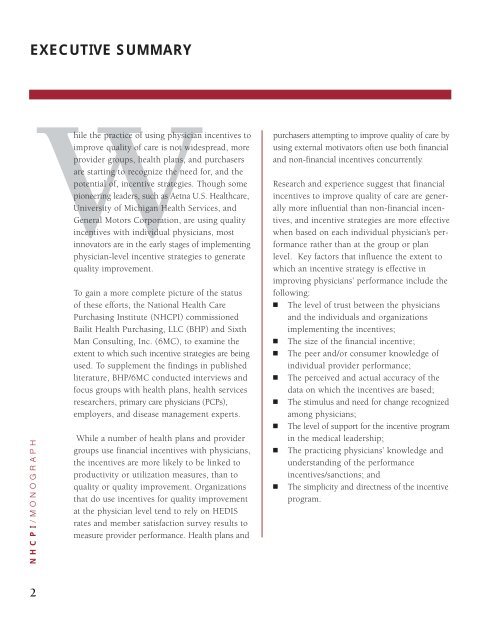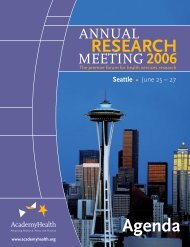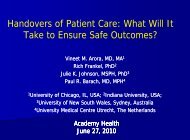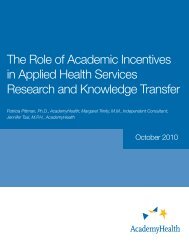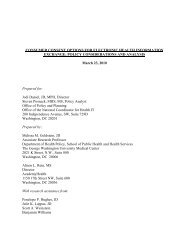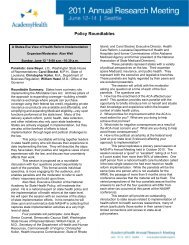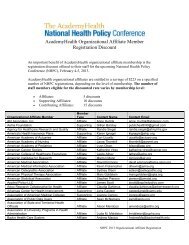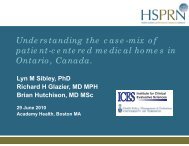The Growing Case for Using Physician Incentives to - AcademyHealth
The Growing Case for Using Physician Incentives to - AcademyHealth
The Growing Case for Using Physician Incentives to - AcademyHealth
You also want an ePaper? Increase the reach of your titles
YUMPU automatically turns print PDFs into web optimized ePapers that Google loves.
EXECUTIVE SUMMARY<br />
NHCPI/MONOGRAPH<br />
While the practice of using physician incentives <strong>to</strong><br />
improve quality of care is not widespread, more<br />
provider groups, health plans, and purchasers<br />
are starting <strong>to</strong> recognize the need <strong>for</strong>, and the<br />
potential of, incentive strategies. Though some<br />
pioneering leaders, such as Aetna U.S. Healthcare,<br />
University of Michigan Health Services, and<br />
General Mo<strong>to</strong>rs Corporation, are using quality<br />
incentives with individual physicians, most<br />
innova<strong>to</strong>rs are in the early stages of implementing<br />
physician-level incentive strategies <strong>to</strong> generate<br />
quality improvement.<br />
To gain a more complete picture of the status<br />
of these ef<strong>for</strong>ts, the National Health Care<br />
Purchasing Institute (NHCPI) commissioned<br />
Bailit Health Purchasing, LLC (BHP) and Sixth<br />
Man Consulting, Inc. (6MC), <strong>to</strong> examine the<br />
extent <strong>to</strong> which such incentive strategies are being<br />
used. To supplement the findings in published<br />
literature, BHP/6MC conducted interviews and<br />
focus groups with health plans, health services<br />
researchers, primary care physicians (PCPs),<br />
employers, and disease management experts.<br />
While a number of health plans and provider<br />
groups use financial incentives with physicians,<br />
the incentives are more likely <strong>to</strong> be linked <strong>to</strong><br />
productivity or utilization measures, than <strong>to</strong><br />
quality or quality improvement. Organizations<br />
that do use incentives <strong>for</strong> quality improvement<br />
at the physician level tend <strong>to</strong> rely on HEDIS<br />
rates and member satisfaction survey results <strong>to</strong><br />
measure provider per<strong>for</strong>mance. Health plans and<br />
purchasers attempting <strong>to</strong> improve quality of care by<br />
using external motiva<strong>to</strong>rs often use both financial<br />
and non-financial incentives concurrently.<br />
Research and experience suggest that financial<br />
incentives <strong>to</strong> improve quality of care are generally<br />
more influential than non-financial incentives,<br />
and incentive strategies are more effective<br />
when based on each individual physician’s per<strong>for</strong>mance<br />
rather than at the group or plan<br />
level. Key fac<strong>to</strong>rs that influence the extent <strong>to</strong><br />
which an incentive strategy is effective in<br />
improving physicians’ per<strong>for</strong>mance include the<br />
following:<br />
<strong>The</strong> level of trust between the physicians<br />
and the individuals and organizations<br />
implementing the incentives;<br />
<strong>The</strong> size of the financial incentive;<br />
<strong>The</strong> peer and/or consumer knowledge of<br />
individual provider per<strong>for</strong>mance;<br />
<strong>The</strong> perceived and actual accuracy of the<br />
data on which the incentives are based;<br />
<strong>The</strong> stimulus and need <strong>for</strong> change recognized<br />
among physicians;<br />
<strong>The</strong> level of support <strong>for</strong> the incentive program<br />
in the medical leadership;<br />
<strong>The</strong> practicing physicians’ knowledge and<br />
understanding of the per<strong>for</strong>mance<br />
incentives/sanctions; and<br />
<strong>The</strong> simplicity and directness of the incentive<br />
program.<br />
2


